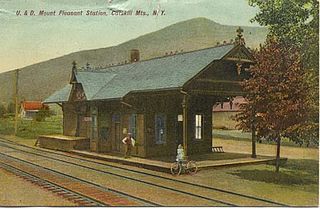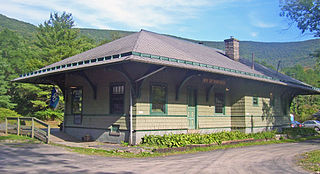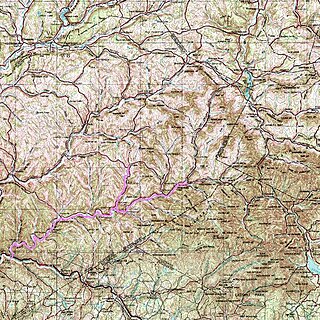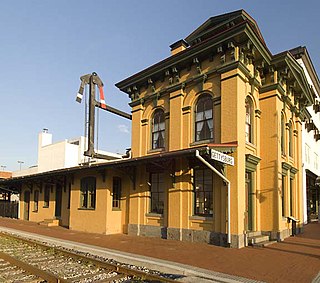The Ulster and Delaware Railroad (U&D) was a railroad located in the state of New York. It was often advertised as "The Only All-Rail Route to the Catskill Mountains." At its greatest extent, the U&D extended 107 miles (172 km) from Kingston Point on the Hudson River through the Catskill Mountains to its western terminus at Oneonta, passing through the counties of Ulster, Delaware, Schoharie and Otsego.
The Catskill Mountain Railroad is a heritage tourist railroad based in Kingston, New York, that began operations in 1982. The railroad leases a 4.7-mile portion of the former New York Central Railroad Catskill Mountain branch from Kingston to Stony Hollow, New York. The tracks are owned by Ulster County, New York, which bought them in 1979 from the bankruptcy estate of the Penn Central Railroad. The railroad's current permit with Ulster County expires on December 31, 2028.
Laurel House station, branch MP 18.5, was built as part of the three-foot gauge Kaaterskill Railroad, an extension of the Stony Clove and Catskill Mountain Railroad. It was built so passengers could stop there and take a carriage to the Laurel House, a hotel that was nearby. When it was built, it was anything but an actual station; in fact, it was nothing but a platform. When the Ulster and Delaware standard-gauged the railroad in 1899, it was replaced with an actual station. The branch it served would become an actual part of the railroad in 1903.
Kaaterskill Junction station, branch MP 11.8, was one of the smallest stations on the Ulster & Delaware, and served as the station at the junction between the Stony Clove and Kaaterskill Branch and the Hunter Branch, hence the word "junction" in its name. The station was originally known as the Tannersville Junction station, but its name was changed soon after it was made.

Mount Pleasant station, MP 24.9 on the Ulster and Delaware Railroad, served the town of Mount Pleasant, New York, and was three miles from the site where the Stony Clove and Kaaterskill Branch separate from the main line at the Phoenicia station.

Phoenicia station is a repurposed train station located on High Street just south of Phoenicia, New York, United States. It is a frame building that opened in 1899.

The Delaware and Northern Railroad was a small railroad in Delaware County, New York, that was founded in 1905, and was planned to go from East Branch, where it would make a connection with the New York, Ontario and Western Railway, to Arkville, where it would connect with the Ulster and Delaware. This line ran close to the banks of the East Branch of the Delaware River, and had plans of expansion, but never made it far, only getting to Arkville. The line was scrapped in 1942, when the Pepacton Reservoir took over its right-of-way and forced the D&N to go out of business.
Chichester station was the Ulster and Delaware Railroad's small station that served the village of Chichester, New York, branch MP 1.6. The old Chichester station was a lot like a small shack with a platform on it that was two miles away from the Phoenicia station, and 29.5 miles from Kingston Point. It had a nearby lumber shoot where wood would be delivered to the furniture factory across the creek. The old station burnt down in 1902, and was replaced with a shelter. It didn't generate much business, and was abandoned after the New York Central bought the U&D in 1932, and it was later scrapped.
Edgewood was a former train station for the New York Central Railroad in the hamlet of Edgewood, located in the town of Hunter, Greene County, New York, United States. Built by the Ulster and Delaware Railroad for its branches to Kaaterskill and Hunter, the station opened on September 28, 1881. The station, located 7.9 miles (12.7 km) from the junction at Phoenicia, closed on January 22, 1940.
This Ulster and Delaware station, branch MP 9.8, was at the summit of a grade that went to the Stony Clove Notch, where the Stony Clove Valley narrowed and was but a few yards wide. It was a flagstop, where people would have to signal a train to stop for them. This station never made much business, and was immediately taken out of service when the New York Central took over the U&D on February 1, 1932. It was also a house, and a U&D employee lived there who would walk from Edgewood station to Kaaterskill Junction station to check for fires.
TannersvilleStation was a train station in Tannersville, New York operated by the Ulster and Delaware Railroad. It ceased operation in 1940 and was burned down on March 2, 1966.
Hobart was a former railroad station in the village of Hobart, Delaware County, New York, United States. The station was run by the New York Central Railroad as part of their Catskill Mountain Branch and located 77.5 miles (124.7 km) from the eastern terminus at Kingston Point station in the city of Kingston. Railroad service in Hobart began on December 1, 1884, when the Hobart Branch Railroad opened for service from nearby Stamford station, an extension of 3.61 miles (5.81 km). The station closed when the railroad discontinued service on the branch on March 31, 1954.

Haines Falls is an abandoned train station in Haines Falls, New York. It was owned by the Ulster and Delaware Railroad. The abandoned station was restored in 1999 and is one of two surviving U&D branch stations. It is now the headquarters of the Mountain Top Historical Society. It is also the start of the Kaaterskill Rail Trail, a scenic hiking trail along the former railway.
Kaaterskill station, branch MP 19.1, was one of the busiest railroad stations on the branch lines of the Ulster and Delaware Railroad (U&D). It was near the banks of South Lake in Kaaterskill, New York, and was a major stop for people who wished to stay at the Hotel Kaaterskill or the Catskill Mountain House, which was 0.93 miles from the station.

Ticonderoga station is an Amtrak intercity train station in Ticonderoga, New York. It is served by the single daily round trip of the Adirondack. The station is located about 2 miles (3.2 km) east of downtown Ticonderoga and 0.2 miles (0.32 km) west of the Fort Ticonderoga–Shoreham Ferry landing. It has one low-level side platform on the west side of the single track.

Hunter was a former station on the Hunter Branch of the Ulster and Delaware Railroad (U&D) and was the busiest station on the branch lines of the U&D. Within several yards of the station were the Standard Oil Co. and the Otto Gordon Coal Co. The village of Hunter, which the station serviced, was also home to several popular resorts.

The Gettysburg Railroad was a railway line in Pennsylvania that operated from 1858 to 1870 over the 17-mile (27 km) main line from the terminus in Gettysburg to the 1849 Hanover Junction. After becoming the Susquehanna, Gettysburg & Potomac Railway line in 1870, the tracks between Gettysburg and Hanover Junction became part of the Hanover Junction, Hanover and Gettysburg Railroad in 1874, the Baltimore and Harrisburg Railway in 1886, and the Western Maryland Railway in 1917. Today, its line is part of the CSX Hanover Subdivision.
The Chestnut Hill East Branch is a railway line in Pennsylvania. It runs 5.5 miles (8.9 km) from a junction with the SEPTA Main Line in Nicetown–Tioga, a neighborhood in Philadelphia, to Chestnut Hill, Philadelphia. The oldest part of it was built in 1832 by the Philadelphia, Germantown and Norristown Railroad. It was part of the Reading Company system from 1870 until 1976. Today it is owned by SEPTA and hosts the Chestnut Hill East Line commuter rail service. The line runs roughly parallel to the Chestnut Hill West Branch, formerly of the Pennsylvania Railroad.
The Fox Chase Branch, formerly the Newtown Branch, is a railway line in the state of Pennsylvania. It runs 4.9 miles (7.9 km) from a junction with the SEPTA Main Line near Wayne Junction to Fox Chase. At its fullest extent, it continued another fifteen miles north to Newtown. The oldest part of it was built in 1876 by the Philadelphia, Newtown and New York Railroad. It was part of the Reading Company system from 1879 until 1976. Today it is owned by SEPTA and hosts the Fox Chase Line commuter rail service.






